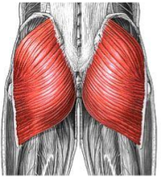Gluteus Maximus
About
Most people think this is muscle if just for sitting. In reality, without the gluteus maximus we would not be able to walk or stand. Trigger points in this area can cause pain in the buttocks itself and in the lower back.
The gluteal muscles work when you do just about anything, but strongly contract when running, jumping, squatting or bending over. This allows them to be open to a range of trigger points.
Symptoms
The pain from trigger points in this region don’t extend very far away or to other parts of the body, which makes it easier to detect. The pain is generally felt around the buttocks area or hips. You may feel stiff and have to constantly adjust your position whilst seated due to a burning pain. Another indicator of trigger points in the gluteus maximus is not being able to bend over and touch your toes, or getting a burning sensation through the top part of the back of you legs while doing so.
It can often be misdiagnosed as bursitis of the hip or arthritis.
Causes
Unaccustomed gym exercises, falling and even sitting on hard office chairs can all cause trigger points within the buttocks area.
Trigger points located on other areas, such as the abdominals or thighs can put even more strain on to the gluteus maximus.
A simple lifestyle check can help you identify causes as well. For instance if you sit virtually all day, you are more likely to create trigger points in the gluteals, as they are not use to the lengthening of the muscles that come with moving around.
Treatment
The gluteus maximus is probably one of the most known and obvious muscles in the body. It covers the entire buttocks region.
To treat this area, you can use a tennis ball or something a bit bigger, and lay on the floor with one knee to your chest and begin to roll around on it.
Slow, deep pressure can effectively relieve a trigger point when treated multiple times a day for a couple of days, the improvement is generally felt immediately.
Unaccustomed gym exercises, falling and even sitting on hard office chairs can all cause trigger points within the buttocks area.
Trigger points located on other areas, such as the abdominals or thighs can put even more strain on to the gluteus maximus.
A simple lifestyle check can help you identify causes as well. For instance if you sit virtually all day, you are more likely to create trigger points in the gluteals, as they are not use to the lengthening of the muscles that come with moving around.
Treatment
The gluteus maximus is probably one of the most known and obvious muscles in the body. It covers the entire buttocks region.
To treat this area, you can use a tennis ball or something a bit bigger, and lay on the floor with one knee to your chest and begin to roll around on it.
Slow, deep pressure can effectively relieve a trigger point when treated multiple times a day for a couple of days, the improvement is generally felt immediately.



















